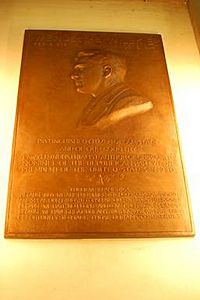Wendell Willkie (relief) facts for kids
Quick facts for kids Wendell Willkie (Fjelde) |
|
|---|---|
 |
|
| Artist | Paul Fjelde |
| Type | Bronze |
| Dimensions | 128.9 cm × 84.5 cm × 2.5 cm (50.75 in × 33.25 in × 1 in) |
| Location | Indiana Statehouse, Indianapolis, Indiana, United States |
| 39°46′7.54″N 86°9′45.54″W / 39.7687611°N 86.1626500°W | |
| Owner | State of Indiana |
The Wendell Willkie plaque is a special bronze artwork at the Indiana Statehouse in Indianapolis, Indiana. It was created by an American artist named Paul Fjelde. This plaque honors Wendell L. Willkie (1892–1944), who was an important person in American politics. He ran for President of the United States in 1940 as the Republican Party candidate. The plaque was placed in the Statehouse rotunda on February 18, 1950. A famous quote from Willkie's book "One World" is written at the bottom of the plaque. This quote talks about the idea of a united world.
Contents
What Does the Wendell Willkie Plaque Look Like?
The plaque shows a picture of Wendell Willkie. His name and the years he lived (1892–1944) are at the top. Willkie's image is in the middle, facing to the left. He is shown without a beard, wearing a suit and tie.
Words on the Plaque
Below Willkie's picture, there are words that describe him. It says he was a "Distinguished citizen of our state and our country." It also mentions that he was a lawyer and a business leader. The plaque notes that he wrote the book "One World." It also reminds us that he was the Republican candidate for President in 1940.
Willkie's Famous Quote
Under these descriptions, there is an eagle symbol. Below the eagle, a powerful quote from Willkie's book "One World" is written. It says:
I believe in America
Because in it we are free—free to choose our government
and speak our minds to observe our different religions
because we hate no people and covet no peoples land
because we have great dreams and because we have the
opportunity to make those dreams come true.
The plaque is quite large, measuring about 50.75 inches tall, 33.25 inches wide, and 1 inch thick. The artist's name, "Paul Fjelde•sc.", is signed at the bottom right. In 2006, the Indiana State Museum said the plaque was in excellent condition.
Why Was the Plaque Created?
The Wendell Willkie plaque was put in the Indiana Statehouse on February 18, 1950. This date was special because it was Willkie's 58th birthday. About 500 people came to the dedication ceremony to honor him. Willkie's family members were there too, including his wife, son, and brother.
Where is the Plaque Located?
The plaque is on the main floor of the Indiana Statehouse rotunda. It faces another bronze plaque that has "The American's Creed" written on it. The Governor of Indiana at the time, Henry F. Schricker, accepted the plaque for the people of Indiana. A young boy from Indianapolis, Jack Scott, had the special job of pulling the cover off the plaque.
How the Idea for the Plaque Started
The idea for this plaque came from Mrs. Ed Toner. Her son, William Toner, was a good friend of Willkie's. Mrs. Toner wanted the plaque to be a gift from everyday people in Madison County, Indiana. Willkie was very fond of the people there.
Raising Money for the Plaque
Since it was hard for them to raise money alone, the Junior Chamber of Commerce groups from Elwood, Anderson, and Alexandria helped. They needed to collect $2,500 for the memorial. People gave all kinds of donations, from small pennies and nickels to larger amounts. School children even contributed about ten percent of the total money raised.
Who Was the Artist, Paul Fjelde?
The artist who created this Wendell Willkie plaque was Paul Fjelde. He was born in Minneapolis, Minnesota, on August 12, 1892, and passed away on May 3, 1984. Fjelde also made two other Wendell Willkie plaques. One is in the Summit County Courthouse in Akron, Ohio, and the other is in New York City.
How the Plaque Was Made
To make the plaque, Fjelde first carved Willkie's face into clay. He used a picture of Willkie as a guide. After the clay carving was finished, the bronze plaque was made using a method called lost-wax casting. This is a very old and detailed way to create metal sculptures.

